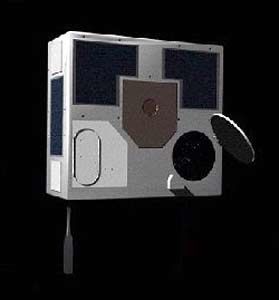Most (original) (raw)

Home - Search - Browse - Alphabetic Index: 0- 1- 2- 3- 4- 5- 6- 7- 8- 9
A- B- C- D- E- F- G- H- I- J- K- L- M- N- O- P- Q- R- S- T- U- V- W- X- Y- Z
Most

Most
Credit: Manufacturer Image
Canadian visible astronomy satellite. MOST was a suitcase-sized microsatellite designed to probe stars and extrasolar planets by measuring tiny light variations undetectable from Earth. Astronomy satellite built by Dynacon Enterprises Ltd. for CSA, Canada. Launched 2003.
AKA: Microvariability and Oscillations Of STars. Status: Operational 2003. First Launch: 2003-06-30. Last Launch: 2003-06-30. Number: 1 . Gross mass: 60 kg (132 lb). Height: 0.65 m (2.13 ft). Span: 0.30 m (0.98 ft).
This was done with a small telescope (15 cm aperture) using new Canadian attitude control technology. The satellite was also equipped with an amateur radio payload.
More at: Most.
Family: Astronomy, Visible astronomy satellite. Country: Canada. Launch Vehicles: UR-100N, Rokot. Launch Sites: Plesetsk, Plesetsk LC133/3. Agency: CSA, Dynacon. Bibliography: 2, 12856.
2003 June 30 - . Launch Site: Plesetsk. Launch Complex: Plesetsk LC133/3. LV Family: UR-100N. Launch Vehicle: Rokot.
- Most - . Mass: 66 kg (145 lb). Nation: Canada. Agency: CSA. Class: Astronomy. Type: Astroseismology satellite. Spacecraft: Most. USAF Sat Cat: 27843 . COSPAR: 2003-031D. Apogee: 834 km (518 mi). Perigee: 818 km (508 mi). Inclination: 98.70 deg. Period: 101.40 min.
MOST (Microvariability and Oscillations of Stars) was a Canadian Space Agency project with a 0.15m telescope which would make photometric observations of stars down to mag 6 with 1 part per million accuracy in the 3500-7000 Angstrom band. Canada's tiny "humble space telescope", celebrated its tenth anniversary of operations in 2013.
Home - Search - Browse - Alphabetic Index: 0- 1- 2- 3- 4- 5- 6- 7- 8- 9
A- B- C- D- E- F- G- H- I- J- K- L- M- N- O- P- Q- R- S- T- U- V- W- X- Y- Z
© 1997-2019 Mark Wade - Contact
© / Conditions for Use